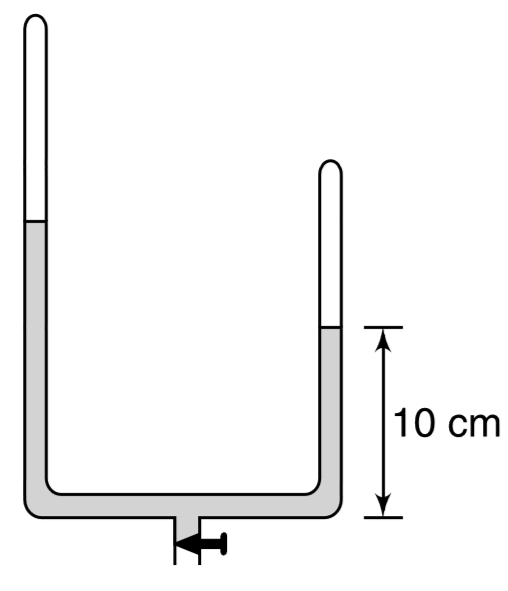The mercury manometer consists of two unequal arms of equal cross section and lengths and . The two open ends are sealed with air in the tube at a pressure of of mercury. Some amount of mercury is now introduced in the manometer through the stopcock connected to it. If mercury rises in the shorter tube to a length in steady state, find the length of the mercury column risen in the longer tube.
Let and be the pressures in of mercury in the two arms after introducing mercury in the tube. Let height of mercury column in longer tube . using .
Shorter tube:
Longer tube : (i)

From figure
(ii)
in (iii)
Solving
Topper's Solved these Questions
Similar Questions
The mercury manometer consists if two unequal arms of equal cross section 1 cm^(2) and lenghths 100cm and 50cm. The two open ends are sealed with air in the tube at a pressure of 80cm of mercurey. Some amount of mercury is now introduced in the manometer through the stopcock connected to it. If mercury rises in the shorter tube to a lenght 10cm in steady state, find the length of the mercury column risen in the longer tube.
View SolutionA U shaped tube has two arms of equal cross section and lengths l1=80 cm and l2=40 cm. The open ends are sealed with air in the tube at a pressure of 80 cm of mercury. Some mercury is now introduced in the tube through a stopcock connected at the bottom (the air is not allowed to leak out). In steady condition the length of mercury column in the shorter arm was found to be 10 cm. Find the length of the mercury column in the longer arm. Neglect the volume of the part of the tube connecting two arms and assume that the temperature is constant.
 View Solution
View Solution
Knowledge Check
- Question 1 - Select One
A mercury barometer reads 75cm in vertical position . If the tube is inclined by 60∘ to the vertical, the length of the mercury in the tube will be
A37.5 cmB75cmC112.5cmD150cm - Question 2 - Select One
An open U-tube contains mercury. When 11.2 cm of water is poured into one of the arms of the tube, how high does the mercury rise in the other arm from its initial level ?
A0.82 cmB1.35 cmC0.41 cmD2.32 cm
A barometer reads 75cm if mercury. When 2.0cm3 of air at atmospheric pressure is introduced into space above the mercury level, the volume of this space cecones 50cm3. find the length by which the mercury column desecds.
View SolutionA barometer tube reads 75 cm of Hg. If tube is : gradually inclined at an angle of 30∘ with horizontal, keeping the open end in the mercury container, then find the length of mercury column in the barometer ■ tube
View SolutionThe hieght of a mercury barometer is 75.6 cm . the baromter tube has cross -section of 1cm2 and the volume of the enclosed space above the mercury surface is 10 cc. one cc of air at atmospheric pressure is introduced into the tube. Find the change in the reading of the barometer.
View SolutionOne of the limbs of a mercury manometer is connected to a gas cylinder. The mercury level in the limb connected to the gas cylinder is 10 cm higher than that in the other limb. Then the gauge pressure of the gas is ____ cm of Hg.
View SolutionA berometer correctlu reads the atmospheric pressure as 76cm of mercury. Water droplets are slowly introduced into the barometer tube by a dropper. The height of the mercury column first decreases and then become constant. If the saturation vapour pressure at the atmospheric tgemperature is 0.80cm of mercury, find the height if the mercury column when it reaches its minimum value.
View SolutionA pressure exerted by mercury at the bottom of a container of area of cross section 2cm2 is 10 Pa. Determine the weight of the mercury in the container.
View Solution

